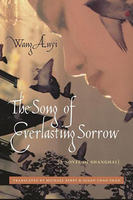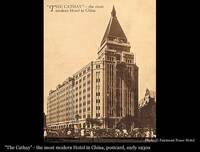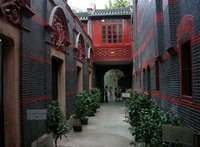-
 The Song of Everlasting Sorrow
The Song of Everlasting Sorrow The Song of Everlasting Sorrow, a novella by Shanghainese author Wang Anyi set in post-WW2 Shanghai. Originally published in Mandarin, this artifact is the English translation.
-
 Example of Spoken Shanghainese
Example of Spoken Shanghainese Video of a NYU Shanghai student speaking Shanghainese with her grandmother. Shanghainese is mutually unintelligible from other Sinitic languages, meaning Mandarin speakers cannot understand Shanghainese and vice versa.
-
 In the Mood for Love 20th Anniversary Trailer
In the Mood for Love 20th Anniversary Trailer A trailer for the film In the Mood for Love (2000) dir. Wong Kar-wai. Though set in Hong Kong, the film's protagonists bond over their shared status as Shanghainese expats and mutual feelings of cultural connectedness. The film also features dialogue in Shanghainese.
-
 Peace Hotel in Shanghai -- Early 1930s
Peace Hotel in Shanghai -- Early 1930s A photo of the Peace Hotel (now the Fairmont Peace Hotel) in Shanghai. Built in 1926 and located on the Bund, a protected historical district in Shanghai, the Peace Hotel is an iconic example of Shanghai's distinct Art Deco architectural style. Combining Western techniques of symmetry and geometry with traditional Chinese styles, Shanghai Art Deco buildings speak to the city's metropolitan culture.
-
 Traditional Shikumen
Traditional Shikumen A photo of the interior courtyard of a traditional shikumen housing structure in the Huangpu District in Shanghai. Shikumen were multi-unit housing structures with courtyards that are unique to Shanghai and, at one point, made up over half of all housing structures in the city. The shikumen in the photo was converted into The Museum of the First National Congress of the Chinese Communist Party in 1961 and is a protected cultural heritage site in China.
-
 My Shanghai: Recipes and Stories from a City on the Water
My Shanghai: Recipes and Stories from a City on the Water A Shanghainese cookbook.
-
 Shanghai Huju Opera Troupe
Shanghai Huju Opera Troupe The Shanghai Huju Opera Troupe prepares for performances during the COVID-19 pandemic. Huju opera is a regional opera unique to Shanghai and performed in Shanghainese. Unlike other traditional forms of Chinese opera, performers' costumes typically reflect 20th century styles and subject matter tends to be contemporary.
-
 Cheongsam
Cheongsam A cheongsam (also called a qipao, or mandarin dress) in the 1930s Shanghai style. Although the cheongsam is not unique to Shanghai, the dress was first popularized in the city. Less traditional than their Beijing counterparts, the Shanghai cheongsam can be identified through its lighter material, narrow piping, and structural tailoring. Note the slim gold metal piping and the light purple silk.
 The Song of Everlasting Sorrow The Song of Everlasting Sorrow, a novella by Shanghainese author Wang Anyi set in post-WW2 Shanghai. Originally published in Mandarin, this artifact is the English translation.
The Song of Everlasting Sorrow The Song of Everlasting Sorrow, a novella by Shanghainese author Wang Anyi set in post-WW2 Shanghai. Originally published in Mandarin, this artifact is the English translation. Example of Spoken Shanghainese Video of a NYU Shanghai student speaking Shanghainese with her grandmother. Shanghainese is mutually unintelligible from other Sinitic languages, meaning Mandarin speakers cannot understand Shanghainese and vice versa.
Example of Spoken Shanghainese Video of a NYU Shanghai student speaking Shanghainese with her grandmother. Shanghainese is mutually unintelligible from other Sinitic languages, meaning Mandarin speakers cannot understand Shanghainese and vice versa. In the Mood for Love 20th Anniversary Trailer A trailer for the film In the Mood for Love (2000) dir. Wong Kar-wai. Though set in Hong Kong, the film's protagonists bond over their shared status as Shanghainese expats and mutual feelings of cultural connectedness. The film also features dialogue in Shanghainese.
In the Mood for Love 20th Anniversary Trailer A trailer for the film In the Mood for Love (2000) dir. Wong Kar-wai. Though set in Hong Kong, the film's protagonists bond over their shared status as Shanghainese expats and mutual feelings of cultural connectedness. The film also features dialogue in Shanghainese. Peace Hotel in Shanghai -- Early 1930s A photo of the Peace Hotel (now the Fairmont Peace Hotel) in Shanghai. Built in 1926 and located on the Bund, a protected historical district in Shanghai, the Peace Hotel is an iconic example of Shanghai's distinct Art Deco architectural style. Combining Western techniques of symmetry and geometry with traditional Chinese styles, Shanghai Art Deco buildings speak to the city's metropolitan culture.
Peace Hotel in Shanghai -- Early 1930s A photo of the Peace Hotel (now the Fairmont Peace Hotel) in Shanghai. Built in 1926 and located on the Bund, a protected historical district in Shanghai, the Peace Hotel is an iconic example of Shanghai's distinct Art Deco architectural style. Combining Western techniques of symmetry and geometry with traditional Chinese styles, Shanghai Art Deco buildings speak to the city's metropolitan culture. Traditional Shikumen A photo of the interior courtyard of a traditional shikumen housing structure in the Huangpu District in Shanghai. Shikumen were multi-unit housing structures with courtyards that are unique to Shanghai and, at one point, made up over half of all housing structures in the city. The shikumen in the photo was converted into The Museum of the First National Congress of the Chinese Communist Party in 1961 and is a protected cultural heritage site in China.
Traditional Shikumen A photo of the interior courtyard of a traditional shikumen housing structure in the Huangpu District in Shanghai. Shikumen were multi-unit housing structures with courtyards that are unique to Shanghai and, at one point, made up over half of all housing structures in the city. The shikumen in the photo was converted into The Museum of the First National Congress of the Chinese Communist Party in 1961 and is a protected cultural heritage site in China. My Shanghai: Recipes and Stories from a City on the Water A Shanghainese cookbook.
My Shanghai: Recipes and Stories from a City on the Water A Shanghainese cookbook. Shanghai Huju Opera Troupe The Shanghai Huju Opera Troupe prepares for performances during the COVID-19 pandemic. Huju opera is a regional opera unique to Shanghai and performed in Shanghainese. Unlike other traditional forms of Chinese opera, performers' costumes typically reflect 20th century styles and subject matter tends to be contemporary.
Shanghai Huju Opera Troupe The Shanghai Huju Opera Troupe prepares for performances during the COVID-19 pandemic. Huju opera is a regional opera unique to Shanghai and performed in Shanghainese. Unlike other traditional forms of Chinese opera, performers' costumes typically reflect 20th century styles and subject matter tends to be contemporary. Cheongsam A cheongsam (also called a qipao, or mandarin dress) in the 1930s Shanghai style. Although the cheongsam is not unique to Shanghai, the dress was first popularized in the city. Less traditional than their Beijing counterparts, the Shanghai cheongsam can be identified through its lighter material, narrow piping, and structural tailoring. Note the slim gold metal piping and the light purple silk.
Cheongsam A cheongsam (also called a qipao, or mandarin dress) in the 1930s Shanghai style. Although the cheongsam is not unique to Shanghai, the dress was first popularized in the city. Less traditional than their Beijing counterparts, the Shanghai cheongsam can be identified through its lighter material, narrow piping, and structural tailoring. Note the slim gold metal piping and the light purple silk.